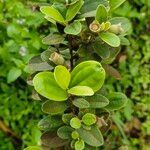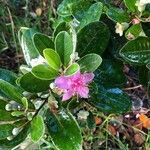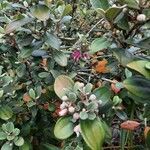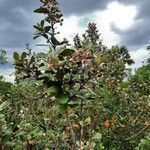Shrubs, 1-2 m tall. Branchlets grayish tomentose. Leaves opposite; petiole 4-7 mm; leaf blade elliptic to obovate, 3-8 × 1-4 cm, leathery, pubescent when young but glabrescent and shiny with age, abaxially gray tomentose, secondary veins 1 on each side of midvein, originating near leaf blade base, and meeting at apex, tertiary veins 4-6 on each side of midvein and connecting midvein to secondary veins, reticulate veins obvious, intramarginal veins 3-4 mm from margin, base broadly cuneate, apex rounded to obtuse and often slightly emarginate or sometimes slightly apiculate. Flowers 1[-3], stipitate, 2-4 cm in diam. Hypanthium obovoid, ca. 6 mm, gray tomentose. Calyx lobes 5, subrounded, 4-5 mm, persistent. Petals 5, violet, obovate, 1.3-2 cm. Stamens red, 7-8 mm. Ovary 3(or 4)-loculed. Style ca. 1 cm. Berry purplish black when mature, urceolate, 1.5-2 × 1-1.5 cm. Fl. Apr-May.
More
A shrub. It grows 1-2 m tall. The leaves are opposite, leathery and pointed at the base and slightly pointed at the tip. They are hairy underneath. The leaves have 3 veins. The flowers are showy. They are pink and have S shaped petals. They occur in the axils of leaves. The fruit are small yellow berries. They can be greenish-purple. They contain several seeds. The flesh is sweet.
A tropical plant. It suits cool tropical and subtropical conditions. It grows in shrubby savannas. It grows in wet forests up to 2,400 m above sea level. Found only in northern Luzon and the Babuyanes islands in the Philippines. It can tolerate wet soil conditions. It can grow in acid soils with pH 4-5. It cannot tolerate frost. In Yunnan.
More
Thrives in open, often degraded sandy sites, along the shore and on river banks. Where it grows, other plants seem not to be able to compete with it, hence almost pure stands exist.





